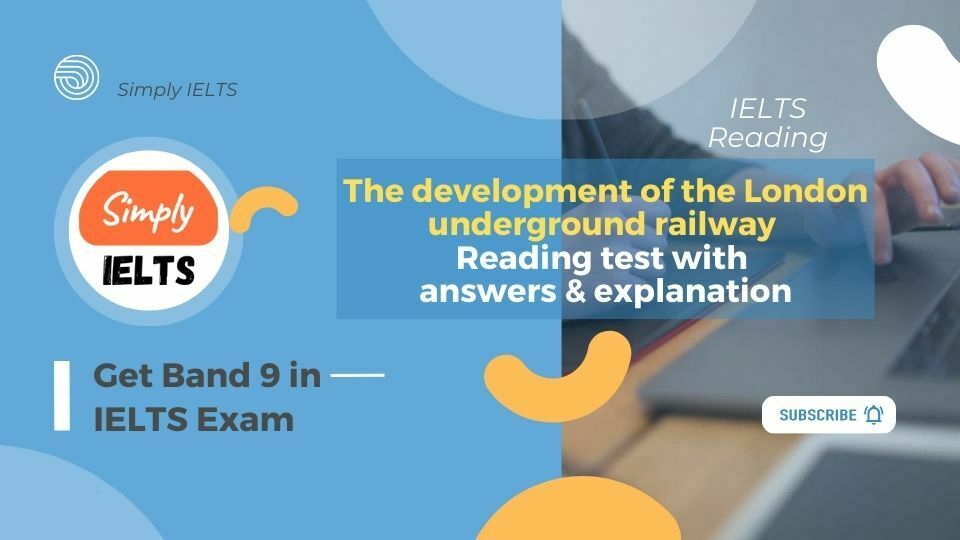The development of the London underground railway Reading test with answers and explanation
A new IELTS Reading Academic test passage 1 from Cambridge IELTS 17 Reading test 3 “The development of the London underground railway” Reading answers with location.
In this IELTS Reading exam, you will find The development of the London underground railway reading answers with location

In the answer tab, you can find The development of the London underground railway reading answers with location
READING PASSAGE 1
You should spend about 20 minutes on Questions 1-13 which are based on Reading Passage 1 below.
The development of the London underground railway
In the first half of the 1800s, London’s population grew at an astonishing rate, and the central area became increasingly congested. In addition, the expansion of the overground railway network resulted in more and more passengers arriving in the capital. However, in 1846, a Royal Commission decided that the railways should not be allowed to enter the City, the capital’s historic and business centre. The result was that the overground railway stations formed a ring around the City. The area within consisted of poorly built, overcrowded slums and the streets were full of horse-drawn traffic. Crossing the City became a nightmare. It could take an hour and a half to travel 8 km by horse-drawn carriage or bus. Numerous schemes were proposed to resolve these problems, but few succeeded.
Amongst the most vocal advocates for a solution to London’s traffic problems was Charles Pearson, who worked as a solicitor for the City of London. He saw both social and economic advantages in building an underground railway that would link the overground railway stations together and clear London slums at the same time. His idea was to relocate the poor workers who lived in the inner-city slums to newly constructed suburbs, and to provide cheap rail travel for them to get to work. Pearson’s ideas gained support amongst some businessmen and in 1851 he submitted a plan to Parliament. It was rejected, but coincided with a proposal from another group for an underground connecting line, which Parliament passed.
The two groups merged and established the Metropolitan Railway Company in August 1854. The company’s plan was to construct an underground railway line from the Great Western Railway’s (GWR) station at Paddington to the edge of the City at Farringdon Street – a distance of almost 5 km. The organisation had difficulty in raising the funding for such a radical and expensive scheme, not least because of the critical articles printed by the press. Objectors argued that the tunnels would collapse under the weight of traffic overhead, buildings would be shaken and passengers would be poisoned by the emissions from the train engines. However, Pearson and his partners persisted.
The GWR, aware that the new line would finally enable them to run trains into the heart of the City, invested almost £250,000 in the scheme. Eventually, over a five-year period, £1m was raised. The chosen route ran beneath existing main roads to minimise the expense of demolishing buildings. Originally scheduled to be completed in 21 months, the construction of the underground line took three years. It was built just below street level using a technique known as ‘cut and cover’. A trench about ten metres wide and six metres deep was dug, and the sides temporarily help up with timber beams. Brick walls were then constructed, and finally a brick arch was added to create a tunnel. A two-metre-deep layer of soil was laid on top of the tunnel and the road above rebuilt.
The Metropolitan line, which opened on 10 January 1863, was the world’s first underground railway. On its first day, almost 40,000 passengers were carried between Paddington and Farringdon, the journey taking about 18 minutes. By the end of the Metropolitan’s first year of operation, 9.5 million journeys had been made.
Even as the Metropolitan began operation, the first extensions to the line were being authorised; these were built over the next five years, reaching Moorgate in the east to London and Hammersmith in the west. The original plan was to pull the trains with steam locomotives, using firebricks in the boilers to provide steam, but these engines were never introduced. Instead, the line used specially designed locomotives that were fitted with water tanks in which steam could be condensed. However, smoke and fumes remained a problem, even though ventilation shafts were added to the tunnels.
Despite the extension of the underground railway, by the 1880s, congestion on London’s streets had become worse. The problem was partly that the existing underground lines formed a circuit around the centre of London and extended to the suburbs, but did not cross the capital’s centre. The ‘cut and cover’ method of construction was not an option in this part of the capital. The only alternative was to tunnel deep underground.
Although the technology to create these tunnels existed, steam locomotives could not be used in such a confined space. It wasn’t until the development of a reliable electric motor, and a means of transferring power from the generator to a moving train, that the world’s first deep-level electric railway, the City & South London, became possible. The line opened in 1890, and ran from the City to Stockwell, south of the River Thames. The trains were made up of three carriages and driven by electric engines. The carriages were narrow and had tiny windows just below the roof because it was thought that passengers would not want to look out at the tunnel walls. The line was not without its problems, mainly caused by an unreliable power supply, Although the City & South London Railway was a great technical achievement, it did not make a profit. Then, in 1900, the Central London Railway, known as the ‘Tuppenny Tube’, began operation using new electric locomotives. It was very popular and soon afterwards new railways and extensions were added to the growing tube network. By 1907, the heart of today’s Underground system was in place.
Now start to answer “Could urban engineers learn from dance” questions. You will have 20 minutes to answer questions 1 to 13.
.You can download answers as a pdf file from here:
The development of the London underground railway IELTS reading Questions
The development of the London underground railway Reading Passage answers with location
| Questions | Answers |
|---|---|
| 1 | population |
| 2 | suburbs |
| 3 | businessmen |
| 4 | funding |
| 5 | press |
| 6 | soil |
| 7 | FALSE |
| 8 | NOT GIVEN |
| 9 | TRUE |
| 10 | TRUE |
| 11 | FALSE |
| 12 | FALSE |
| 13 | NOT GIVEN |
The development of the London underground railway Reading Passage answers explanations
Question 1 Explanation
Question: The 1___________ of London increased rapidly between 1800 and 1850.
Comparing with the phrase in the question and the reading passage, we have:
- The population of London ⇔ London’s population
- Increased rapidly ⇔ grew at an astonishing rate
- between 1800 and 1850 ⇔ In the first half of the 1800s
Correct Answer: population
Question 2 Explanation
Question: Building the railway would make it possible to move people to better housing in the 2_________.
Comparing with the phrase in the question and the reading passage , we have:
- People ⇔ poor workers
- Better housing ⇔ newly constructed
- Move people to better housing in the suburbs ⇔ relocate poor workers to newly constructed suburbs
Correct Answer: suburbs
Question 3 Explanation
Question: A number of 3_________ agreed with Pearson’s idea.
Comparing with the phrase in the question and the reading passage , we have:
- A number of businessmen ⇔ some businessmen
- Agreed with ⇔ support
- Pearson’s idea ⇔ Pearson’s ideas
Correct Answer: businessmen
Question 4 Explanation
Question: The company initially had problems getting the 4 _________ needed for the project Comparing with the phrase in the question and the passage , we have: The company ⇔ The organisation
- Had problems ⇔ had difficulties
- Getting the funding ⇔ raising the funding
- The project ⇔ scheme
Correct Answer: funding
Question 5 Explanation
Question: Negative articles about the project appeared in the _________
Comparing with the phrase in the question and the reading passage , we have:
- Negative articles ⇔ critical articles
- Appeared in the press ⇔ printed by the press
Correct Answer: press
Question 6 Explanation
Question: With the completion of the brick arch, the tunnel was covered with _________
Comparing with the phrase in the question and the reading passage , we have:
- The tunnel ⇔ the tunnel
- was covered with soil ⇔ soil was laid on top of
Correct Answer: soil
Question 7 Explanation
Question: Other countries had built underground railways before the Metropolitan line opened.
Comparing with the phrase in the question and the reading passage , we have:
- Metropolitan line = Metropolitan line
- Other countries had built underground railways before # the world’s first underground railway
Correct Answer: False
Question 8 Explanation
Question: More people than predicted travelled on the Metropolitan line on the first day.
Comparing the clusters in the question with the passage , we have:
- More people than predicted => the reading has no information.
Correct Answer: Not Given
Question 9 Explanation
Quesion: The use of ventilation shafts failed to prevent pollution in the tunnels.
Comparing the clusters in the question with the passage , we have:
- ventilation shafts <=> ventilation shafts
- pollution <=> smoke and fumes
- failed to prevent <=> remained a problem
Correct Answer: True
Question 10 Explanation
Question: A different approach from the ‘cut and cover’ technique was required in London’s central area.
Comparing the clusters in the question with the passage , we have:
- A different approach <=> alternative
Correct Answer: True
Question 11 Explanation
Question: The windows on City & South London trains were at eye level.
Comparing the clusters in the question with the passage , we have:
- trains <=> carriages
- at eye level # below the roof
Correct Answer: False
Question 12 Explanation
Question: The City & South London Railway was a financial success.
Comparing the clusters in the question with the passage , we have:
- financial success # did not make a profit
Correct Answer: False
Question 13 Explanation
Question: Trains on the ‘Tuppenny Tube’ nearly always ran on time.
Comparing the clusters in the question with the passage , we have:
- nearly always ran on time => the reading has no information.
Looking in the text, we see that ‘Tuppenny Tube’ appears at the end of the article, we will read it carefully from here until the end. However, information nearly always ran on time not appear
Correct Answer: Not Given



Sidhu
good way to prepare ielts exam
good
need ans
[email protected]
great